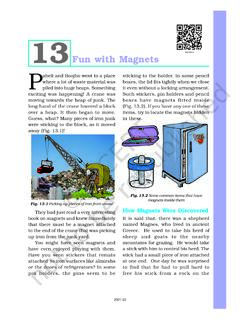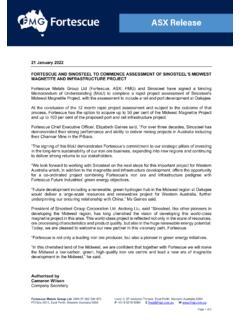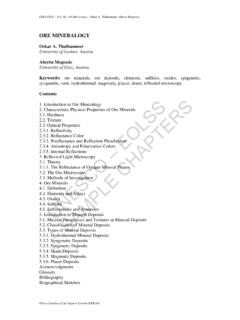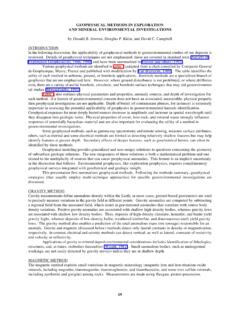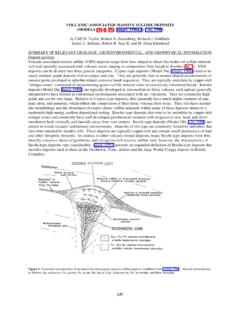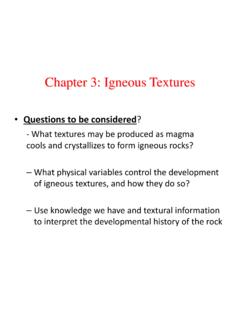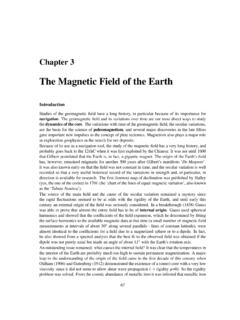Transcription of ALH84001 - NASA
1 Martian Meteorite CompendiumC Meyer 2012 ALH84001 Orthopyroxenite, 1931 gramsFigure 1: Photograph of exterior surface of Martian meteorite ALH84001 . The cube is 1 cm. (NASA # S85-39570)IntroductionALH84001 was found during a snowmobile rideDecember 27th, 1984 in the Far Western Icefield ofAllan Hills and was picked up (as sample number1539) without the usual careful photography. TheANSMET Field Notes describe it as a highly-shocked, grayish-green, achondrite, 90% coveredwith fusion crust (with the additional comment Yowza-Yowza ). Since it was recognized as the mostunusual rock collected, it was the first Antarcticmeteorite to be processed from the 1984-5 field season(Score 1997).The fusion crust has spalled in some areas from thehackly end (W1), exposing a uniform coarse-grainedrock with a greenish-gray color and a blocky texture(figures 1, 2) (Score and MacPherson 1985).
2 Duringpreliminary examination, Mason et al. (1992) notedcleavage planes on some large crystals and that thestone had a shocked appearance. ALH84001 wasoriginally classified as a diogenite by Score andMacPherson (1985) and Mason et al. (1992), althoughthey noted patches of brown Fe-rich carbonate. Preliminary examination classified ALH84001 asweathering category A/B and fracturing category B(moderate cracks).However, during a study of diogenites, Berkley andBoynton (1992) and Mittlefehldt (1993) noted that thechromite in ALH84001 contained substantial Fe+ also noted that the rock contained pyriterather than troilite and had unusual Fe/Mn for adiogenite. Finally, based on oxygen isotope analysis ofClayton (1993) and the above evidence, ALH84001 wasreclassified as a Martian meteorite (Score andMittlefehldt 1993; Mittlefehldt 1994).As explained below, this Martian meteorite has beenfound to have a very old age (~ to ), but ithas suffered several impact events during its history,as evidenced by annealed granular bands and isotropicplagioclase, making age determinations difficult toMartian Meteorite CompendiumC Meyer 2012 Figure 2: Photograph of exterior surface of Martian meteorite ALH84001 .
3 Note the large cavity on this cube is 1 cm. (NASA # S85-39567)Figure 3: Close-up photograph of a small piece of Martian meteorite ALH84001 illustrating roundedcarbonate inclusions with orange interiors and black-white-black rims. Size of round inclusion is ~100-200 microns. This photo, by Monica Grady, was originally published in Nature 374, 616. (NASA photo #S95-00690)Martian Meteorite CompendiumC Meyer 2012 Figure 4: Plane polarized and cross-polarizedphotomicrographs of same area of thin sectionALH84001,64 illustrating the crushed zones in thelarge orthopyroxene grains (field of view is 6 mm).Photographs provided by Mittlefehldt (orginallypublished in Meteoritics 29, 215).Footnote: This sample has been the subject ofconsiderable controversy, which can be bestsummarized by two hypotheses termed BiologicalHypothesis and Abiotic Hypothesis - This sample also has an unusually old cosmic-ray, exposure age (~15 ) for Martian meteorites(figure I-13).
4 A most unusual feature of this rock is the presence ofsmall (100-200 microns), fine-grained, spheroidal areas(called rosettes ) of zoned Mg-Fe-Mn-Ca carbonate(figure 3). Thomas et al. (1995, 1996) and Romaneket al. (1995) proposed that organic matter and smallmagnetite grains associated with the outer rims of thesecarbonate spheroids may have a biological origin. InAugust 1996, D. McKay and eight co-authorspublished their evidence of past biological activity onMars preserved within the outermost black rims of thecarbonate globules of this sample (see section on Biogenic Hypothesis below). Consequently, NASAwas asked to put its full intellectual power andtechnological prowess behind the search for furtherevidence of life on Mars (Kerr 1996). (see footnote) ALH84001 appears to be the first Martian rock studiedin detail where the effects of both alteration and shockhave been studied together.
5 A key observation wasthat the cracks in some carbonate rosettes were offsetby a shock event, demonstrating that the secondaryalteration must have occurred on Mars (see below).Another key observation is that there is more than onegeneration of carbonate deposition (Corrigan et ).Review papers by McSween (1997), Gibson et al.(1997), Gleason et al. (1997), Treiman (1998, 2003),Kring et al. (1998) and Papike et al. (2009) give thereader a framework for what follows. One finds thatthere is not a lot of agreement between research teamsthat have studied the various features of ALH84001 ,but it should be pointed out that each research teamhas received only a small portion of the sample andALH84001 is by no means homogeneous on such asmall scale. (see footnote)PetrographyALH84001 is a coarse-grained, cataclasticorthopyroxenite (97% orthopyroxene, 2% chromite,~1% maskelynite, phosphate) with minor augite,olivine, pyrite and secondary Fe-Mg-Mn-Ca igneous minerals are essentially unzoned whereasthe carbonate is highly zoned in composition.
6 Mason etal. (1992) described a thin section with orthopyroxene crystals up to 5 mm long forming apolygonal-granular mosaic (figures 4a, b). Berkleyand Boynton (1992) reported orthopyroxene grains upto 6 mm, which commonly join in 120 triple junctions(Mittlefehldt 1994a). Chromite is found as euhedralinclusions in the orthopyroxene. Minor maskelynite,chromite and phosphate are found at the olivine inclusions in orthopyroxene occur asclusters adjacent to disrupted carbonate globules andfeldspathic shock glass (Shearer et al. 1999).Martian Meteorite CompendiumC Meyer 2012 Figure 5: Photograph of sawn surface of Martianmeteorite ALH84001 ,65 illustrating the porosity ofthe interior of the sample. (NASA # S94-32547)Figure 6: Photograph of sawn surface of Martianmeteorite ALH84001 ,0 after the second sawcutillustrating the porous crushed zone in the middle ofthe sample where the break occurred during sawing.
7 (NASA # S94-32548).Macroscopic description of hand specimenALH84001,65 by Mittlefehldt (1997) revealed thatgranular bands within the orthopyroxenite were cut byold, pre-terrestrial fractures. The granular bands canbe distinguished by (1) deformed chromites, oftenforming stringers, (2) streaks of light and dark silicates,and (3) a sugary texture. These bands are roughlyplanar, but there is no preferred orientation. Mittlefehldtalso observed that old fracture surfaces cross-cutgranular bands and noted that these old fracture surfacesare distinguishable by, (1) transecting more than onepyroxene grain, (2) a general gently undulating shape,(3) a waxy appearance, and (4) a fine-scale, wavystructure similar to slickensides in appearance. Thin,round to elliptical, disks of color-zoned carbonate werefound to be prevalent along the old fractures. Fromthese observations Mittlefehldt concluded that thesequence was, (1) formation of the granular bands, (2)formation of the old fracture surfaces, and (3) depositionof the rounded, zoned carbonate blebs.
8 Thin sectionsof ALH84001 contain mm-wide bands of crushed andannealed orthopyroxene with a fine granular textureand grain size 10-30 microns (Treiman 1995b). Theoffset along these granular bands is indicated by thelength of sheared chromites (several 100 microns).Photographs of the large sawn surface through thecenter of ALH84001 (figures 5, 6) reveal a centimeter-wide light-colored zone in the center of the rock thathas become known (for allocation purposes) as the crushed zone . Photos of this centimeter-wide bandshow that it has ~5-10 % elongate cavities (possiblyinterconnecting). Thomas et al. (1995) illustrate a SEMphoto of an interior surface of a cavity in this et al. (1997) found a slight difference in thetrace element composition of this zone (figure 10).However, Mittlefehldt (personal communication) foundnothing unusual about the appearance of this region ofthe rock in his examination of the hand specimen (1997).
9 Away from this central zone, the porosity of the mainpart of the rock is only 1-2% and apparently non-penetrating. A few mm-size vesicles or voids can beseen in the photos of the sawn surface (figures 5, 6).The presence of small patches of carbonates alongannealed fractures in ALH84001 has led to numerousstudies. In thin section, some of these carbonatesappear to be replacing maskelynite (Treiman 1995b;Kring et al. 1998). An important debate has beenwhether these carbonates formed at high or lowtemperature (Harvey and McSween 1996; D. McKayet al. 1996; Valley et al. 1997 and Treiman andRomanek 1998). The issue of apparent metasomatismthat must have accompanied the CO2 alteration of thisrock has been studied by Mittlefehldt and Lindstrom(1994a), Wadhwa and Crozaz (1994c, 1995b), Treiman(1995b) and Griffith and Shock (1995) (see the sectionon Carbonate Rosettes ).
10 In summary, detailed petrography of thin sections ofALH84001 shows that, after cooling in an igneousplutonic environment, ALH84001 was subjected to atMartian Meteorite CompendiumC Meyer 2012 Figure 8: Composition diagrams for carbonates inMartian meteorite ALH84001 . This is figure 3 inHarvey and McSween (1996).Figure 7: Composition diagram for pyroxene inALH84001. Only trace olivine and augite is present,with most of the sample orthopyroxene. Datareplotted from Berkley and Boynton (1992),Mittlefehldt (1994), Harvey and Treiman (1994) andTreiman (1995).least two shock events as well as alteration in a CO2-rich fluid (Mittlefehldt 1994a; Treiman 1995b; Gleasonet al. 1997; G. McKay et al. 1998; Treiman 1998;Greenwood and McSween 2001). However, Scott etal. (1998) concluded only one shock event is evident inthe samples studied by them and pointed out that asequence of events can occur in an instant (geologicallyspeaking) during and immediately after an impact seems clear that this rock has had a long and variedhistory (since about ) on the surface of an activeplanet (Mars) (see below).

